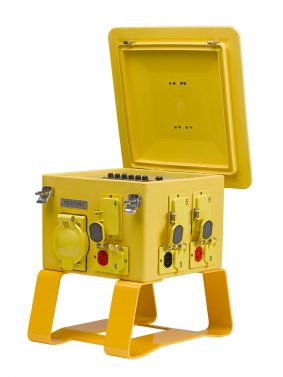Thinking long term about temporary power
 While applications that call for portable power are inherently impermanent, it’s important not to sacrifice safety and increase the risk of trip-and-fall, electric shock, or other injuries at construction sites, street festivals, conventions or any other temporary power scenarios. In fact, since these examples typically require a significant amount of handling and transportation and are often located amid large numbers of people, extra attention should be paid to make sure the portable power equipment is safe, reliable, and built to survive.
While applications that call for portable power are inherently impermanent, it’s important not to sacrifice safety and increase the risk of trip-and-fall, electric shock, or other injuries at construction sites, street festivals, conventions or any other temporary power scenarios. In fact, since these examples typically require a significant amount of handling and transportation and are often located amid large numbers of people, extra attention should be paid to make sure the portable power equipment is safe, reliable, and built to survive.
Typically designed in a cubed or rectangular shape with support legs to keep the units up off the ground, portable power boxes are available in a variety of amperage ratings with various plug and receptacle configurations. As opposed to a traditional painted steel structure, power boxes are also now being offered in vulcanized rubber. A portable power unit featuring 100% rubber construction is resistant to shock, impact and corrosion, and is lighter in weight than its steel counterpart, providing greater reliability and easier transport.
When drawing various levels of current in a portable power application, it is also important to consider power management and ensure a balanced AC current load between phases. Systems that offer numbered and/or color-coded receptacles allow users to intentionally and evenly distribute current loads, build a better running portable power network, and reduce the risk of power shortage.
In any indoor or outdoor area where water may come into contact with electrical products, power products featuring ground fault circuit interrupters (GFCIs) are best used. Designed for protection, reliability, and safety, GFCIs can be placed on individual electrical power cords (in-line GFCI) or deployed systemically to protect an entire system from ground faults, nuisance tripping, and other hazards.
To safely perform every task on a construction site, proper lighting is essential. With the safety and cost benefits associated with LED technology now being made available in several portable lighting solutions, LED string lights, which are also more compact and impact-resistant than their incandescent counterparts, can be treated as reusable assets, getting allocated to a job site and then scanned back into inventory at the end of the job.
When compared to a continuously operating 10-light string of incandescent bulbs, a 10-light LED string is capable of saving building owners or general contractors up to $1,300 per year in energy costs per string. A 10-light LED string light may draw as little as 140W, compared to a 1000-1500W 10-light incandescent string, so in the construction of a multi-floor office building, users may be able to power the temporary lighting for the entire floor using multiple strings connected end to end from a single 15A/1,875W power outlet. This leads to further reduced costs such as less temporary wiring, smaller wire gauges, and fewer generators required to support temporary lighting.
Woodhead has long been a leader in the design and manufacturing of portable and temporary lighting products. These portable power products are safe and dependable sources for temporary power distribution in virtually any environment. Industrial-grade portable outlet boxes are NEC and OSHA compliant, and its high-quality, reliable task lighting products are appropriate for basic commercial duty as well as wet and hazardous locations. With Molex able to supply an entire portable power distribution system and all accessories, customers can simplify their supply base and minimize administrative costs.